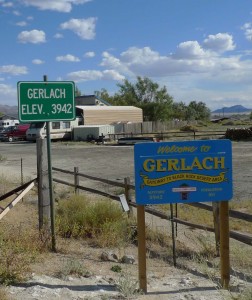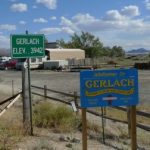

The Nevada Seismological Laboratory at the University of Nevada, Reno reported a magnitude 3.9 earthquake located near the communities of Gerlach and Empire, about 75 miles north of Reno. The earthquake occurred at 7:20 a.m. on Saturday, May 14, 2016. The magnitude 3.9 is the largest of just over 300 earthquakes that have been located in the area since April 20.
Since the sequence began on April 20, there have been four magnitude 3.0 to 4.0 events and 28 earthquakes of magnitude 2.0 to 2.9.
The event was felt in the small communities near the Black Rock Desert, the site of the annual Burning Man event. The Seismological Lab, a public service department in the University’s College of Science, placed a temporary instrument in the Gerlach area Friday, May 13, to improve earthquake locations and supplement poor seismic network coverage in the northern Nevada region.
“We cannot predict how this sequence of earthquakes will evolve or if there will be additional events of near magnitude 4 or larger,” Ken Smith, the seismic network manager, said. “We’re monitoring the swarm closely and updating local emergency management officials in case this sequence might evolve to a larger, damaging earthquake.”
As a public safety reminder, local and state agencies urge the public to be prepared in the event an emergency causes you to be self-reliant for three days without utilities and electricity, water service, access to a supermarket or local services, or maybe even without response from police, fire or rescue.
Washoe County Emergency Manager Aaron Kenneston said Washoe County’s Gerlach Fire Department will be distributing earthquake preparedness brochures in the communities, which have a population of about 300, to remind citizens of earthquake preparedness actions.
“When we feel these smaller earthquakes, it’s nature’s way of telling us that Nevada, and Washoe County, is earthquake country,” Kenneston said. “Today would be an ideal day to walk through your house, or place of work, and do a hazard hunt. Secure bookshelves, water heaters, and items that can easily fall and hurt you. During an earthquake take immediate action to drop, take cover and hold on. And after an earthquake check on your neighbor, know how to turn off your gas and water.”
Gerlach, while located near significant faults, has not experienced a major historical earthquake centered in that area.
“This sequence underscores that rural communities in greater Nevada need to be earthquake ready just as much as city folks do,” Craig dePolo, an earthquake geologist with the University’s Nevada Bureau of Mines and Geology, said.
Since 1975 there have been five earthquakes of magnitude 4.0 to 4.6 located within 25 miles of Gerlach. The most recent, in 2000, were magnitude 4.2 and 4.4 that were located just south of town. During the 1915 Pleasant Valley earthquake, it was reported that three minutes of shaking occurred in Gerlach and that cracks formed in the rail yard and a concrete slab at the train depot, and water pipes were broken.
“This swarm of earthquakes is occurring in a geologically interesting area near the intersection of major faults on the west side of the Fox Range and southwest side of the Granite Mountains,” Jim Faulds, director of the Nevada Bureau of Mines and Geology, said. “These faults have not experienced major earthquakes in historic times but have been active relatively recently, geologically speaking that is, over the past several thousand to tens of thousands of years. Faults like these are common in Nevada, but it is difficult to predict when they might rupture in a major earthquake.”



